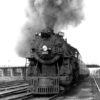calsfoundation@cals.org
Amtrak
Amtrak, with a name derived from the words “America” and “track,” is a partially government-funded American passenger rail service. Its parent enterprise is the National Railroad Passenger Corporation. Amtrak was created in 1970 to provide medium- and long-distance intercity service through the consolidation of existing U.S. passenger rail companies.
Sharing track with freight trains, Amtrak officially took over most U.S. interstate passenger rail service on May 1, 1971. However, Amtrak’s regular passenger rail service did not begin to serve Arkansas until 1974, when service on the Inter-American train was extended northward from Fort Worth, Texas, to St. Louis, Missouri.
Amtrak is the most recent phase in America’s passenger railroad history, in which Arkansas has played a significant part. From the post–Civil War years through the mid-1920s, almost all travelers in the United States who could afford to do so traveled via the privately held rail lines. There were a number of passenger railroad entities in Arkansas, though many were short-lived. Some Arkansans commuted daily by rail from their rural homes to nearby Arkansas colleges in the 1920s, 1930s, and 1940s. However, with the rise of affordable automobiles as well as interstate bus service in the 1920s, the number of rail passengers declined nationwide. The Great Depression of the 1930s further cut into profits. Along with the rest of the nation, Arkansas expanded its rail service again in the 1940s with troop transports and gas rationing during World War II. After the war and into the 1960s, the advent of both airline travel and federally funded interstate highways sent passenger rail into a sharp decline. Arkansas reflected the national trend.
Arkansas had once been crisscrossed with storied railways such as the Frisco, Missouri Pacific, Cotton Belt, Southern Pacific, Rock Island, Burlington Northern, and Union Pacific. Early in its statehood, Arkansas relied heavily on railroads to carry freight both in and out of the state as well as to bring visitors and settlers to expand the population of the state. Arkansas towns were said to live or die depending on availability of rail service.
Freight trains still run steadily through Arkansas, with passenger service handled by Amtrak. By December 2015, the only Amtrak service in Arkansas was the Texas Eagle, which replaced the Inter-American in 1981. The Texas Eagle runs between Chicago, Illinois, and San Antonio, Texas, with connecting service to Los Angeles, California. It offers coach, sleeper, lounge, and dining car service for passengers to forty-one cities and towns between Chicago and Los Angeles, offering connecting service to others.
In Arkansas, Amtrak’s Texas Eagle stops in Walnut Ridge (Lawrence County), Little Rock (Pulaski County), Malvern (Hot Spring County), Arkadelphia (Clark County), Hope (Hempstead County), and Texarkana (Miller County). With its elegant clock tower, the Amtrak station in Little Rock, Union Station, is the state’s most impressive rail depot. Located at 1400 West Markham, it is listed on the National Register of Historic Places.
Prospective Amtrak passengers in Arkansas are often discouraged by the hours during which the Texas Eagle runs through the state. The train’s southbound schedule in 2016 listed departures from Walnut Ridge at 12:37 a.m., Little Rock at 3:10 a.m., Malvern at 3:55 a.m., Arkadelphia at 4:20 a.m., Hope at 5:09 a.m., and Texarkana at 6:58 a.m.
Northbound, Texas Eagle again runs in the darkness, stopping at Texarkana at 8:43 p.m., Hope at 9:18 p.m., Arkadelphia at 10:02 p.m., Malvern at 10:26 p.m., Little Rock at 11:39 p.m. and Walnut Ridge at 1:41 a.m.
Some Arkansas rail passengers also use Amtrak’s City of New Orleans out of nearby Memphis, Tennessee. It runs south to New Orleans, departing Memphis at 6:50 a.m., and northbound to Chicago at 10:40 p.m.
For additional information:
Amtrak. https://www.amtrak.com/home (accessed October 20, 2020).
Goldberg, Bruce. Amtrak: The First Decade. Silver Spring, MD: Alan Books, 1981.
Woods, Stephen E. “The Development of Arkansas Railroads, Part I.” Arkansas Historical Quarterly 7 (Summer 1948): 103–140.
———. “The Development of Arkansas Railroads, Part II.” Arkansas Historical Quarterly 7 (Autumn 1948): 155–193.
Nancy Hendricks
Garland County Historical Society
 Divergent Prosperity and the Arc of Reform, 1968–2022
Divergent Prosperity and the Arc of Reform, 1968–2022 Railroads
Railroads Transportation
Transportation ARCF Headquarters at Union Station
ARCF Headquarters at Union Station 




Comments
No comments on this entry yet.